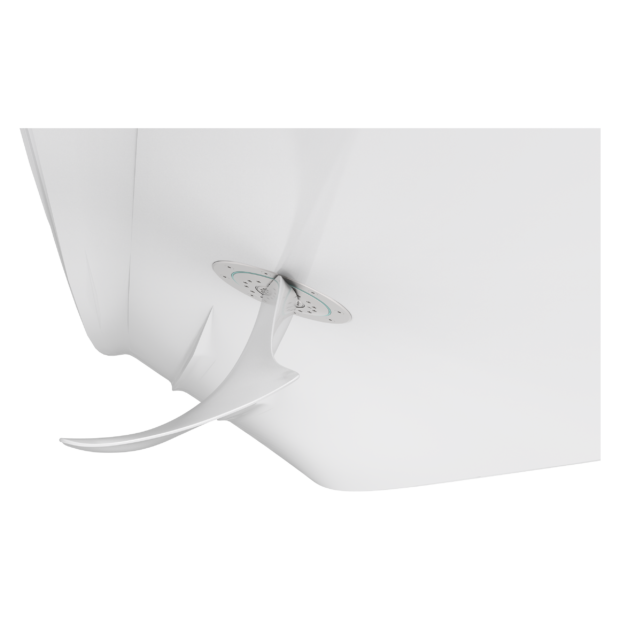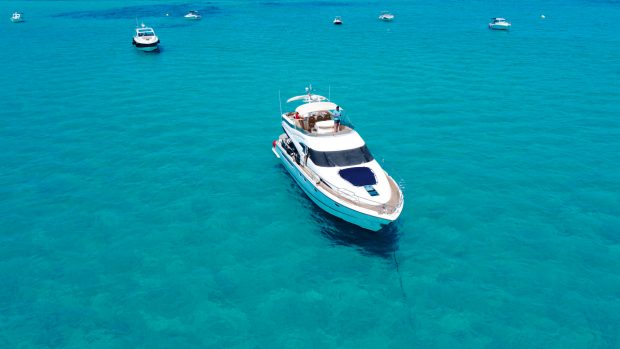DMS's new flapping fins could become a staple for motor boats
Dutch company DMS Holland is hoping to revolutionise the market for stabilisers with a new design of flapping fins specifically designed for fast-planing motor boats.
The company originally made a name for itself with its cylindrical MagnusMaster rotating stabilisers for displacement boats, and last year it launched the AntiRoll ‘flapping’ fins for superyachts. Now it plans to develop this AntiRoll technology into a smaller, cheaper, more effective package for fast production boats.
The key to this new design of high-aspect ratio fin is that they attach to the transom of the boat rather than being fitted through the main section of the hull. This makes them easier to install (the hydraulic actuators of traditional fins often have to be tucked under the floor of the master cabin) and ensures that all the internal workings can be kept in the engine bay, reducing noise disturbance at night.
It also has a number of interesting dynamic benefits. Because the fins rotate on two different axes, they can be swivelled all the way round so that they tuck in behind the transom. This not only reduces drag to negligible levels at high speed, but also enables them to double up as active trim tabs, tilting up and down to correct both roll and lean in much the same way as Humphree’s Active Interceptors. This means that instead of installing separate trim tabs and stabilisers, customers will soon be able to specify one set of AntiRoll stabilisers that should cover every eventuality from trim and lean to stabilisation at high speed, low speed and at anchor.
Although DMS Holland won’t yet reveal the full details of how the new system works across such a wide range of speeds, the illustrations appear to show three different operating modes: high speed, low speed and zero speed.
High-speed mode

At high speed, the fins tuck in along the trailing edge of the transom using small rotations of the fins to deflect the water down and create the lift on one side or the other, much like an oversized trim tab. The large surface area of the fins and high pressure of the water running over them at speed means tiny movements will generate substantial lift.
When combined with fast-acting electric actuators linked to the system’s roll sensor, this should enable them to react to any lean or roll and correct it almost instantaneously. Their ability to tuck away behind the transom will also be handy when it comes to berthing in a marina or manoeuvring in tight spaces.
Low-speed mode

At slower displacement cruising speeds, the fins swivel round into their extended position where they will rotate up and down in the same way as the high-speed mode. Although the slower speed of the water passing over them won’t generate as much pressure, their greater distance from the centre of roll ensures they will still create more than enough lift to counteract any side-to-side rolling. In fact, the long, thin, high-aspect ratio design of the fins, similar in shape to a glider’s wings or the pectoral fins of a humpback whale, not only create 50-75% less drag than the equivalent surface area of conventional fins but are also more efficient at generating lift where it’s needed the most.
Zero-speed mode

Finally, when the boat is at anchor and unable to rely on water passing over the fins to create lift, it reverts to the same actuator used to extend and retract them to flap them up and down like a pair of wings.
Once again, the high-aspect ratio design of the fins, the extra leverage gained from being further away from the boat’s roll centre and the fact that the whole fin is moving up and down rather than pivoting around an axis is claimed to make them more effective than conventional fins.
Although DMS Holland makes no reference to it, we suspect that it may also reduce the paddle effect that causes some boats to ‘swim’ over their own anchor.
One-stop solution
Patrick Noor, co-owner of DMS Holland, says: “Since there is currently no single system that performs optimally at both high speeds and at low speeds as well as at anchor, often multiple roll-damping systems have to be installed on one yacht. Soon, with our new system, one roll- damping system on board will be enough without having to compromise on stability at different speeds.”
Despite these claims, there is one obvious drawback of the new system – the position and size of the fins when retracted makes them unlikely to be suitable for twin sterndrive or multiple outboard engine installations. This rules out the majority of sportscruisers below 45ft, most of which are powered by twin sterndrive setups. However, for shaftdrive or IPS-powered boats, this does look like a very intriguing new prospect.
The AntiRoll technology has already been proven to work on much larger boats – a 37m Van der Valk was fitted with it last year, winning the approval of the ship’s captain and crew, so there is no reason it won’t work equally well on smaller production craft.
Testing under way
According to DMS, a number of major shipyards and dealers have already shown interest in the system and have indicated a willingness to test it on one of their models.
Alexander Jonkers, owner of the Dutch Fairline and Jeanneau dealer, Jonkers Yachts, has agreed to help test the system on one of his craft, adding: “I can’t wait to be able to offer the system to my Fairline and Jeanneau associates. In the meantime, I will support DMS Holland in the development and the first prototype will be tested with us.”
Full details of the new system will be revealed at the METS equipment show in Amsterdam later this year with the first deliveries of production systems scheduled for early 2019. DMS Holland hasn’t yet given any indication of pricing but with
so many players now offering stabilisation systems, it will have to be competitive to make inroads into an already crowded market.
Contact: DMS Holland

Radical retractable stabiliser fins AntiRoll
We test a new dual-axis stabiliser, which promises to be the best of both worlds with retractable flapping fins.

Sleipner stabilising fins on sea trial
This is not the first time we have taken a very serious look at Sleipner’s zero-speed Vector stabilising fins









